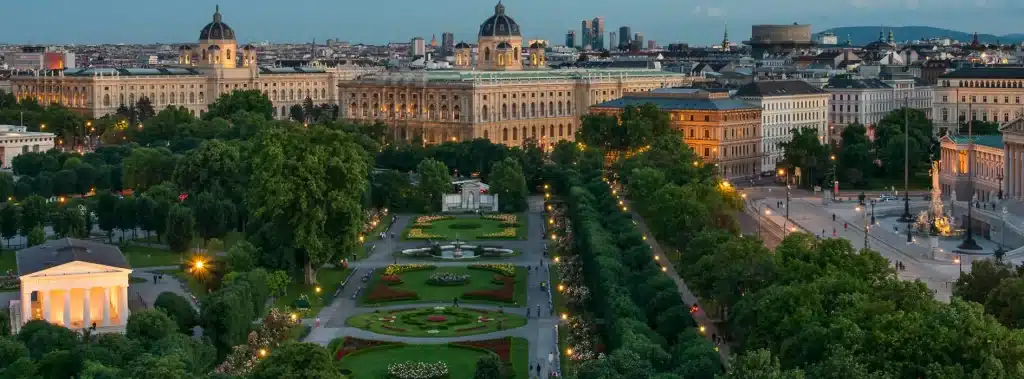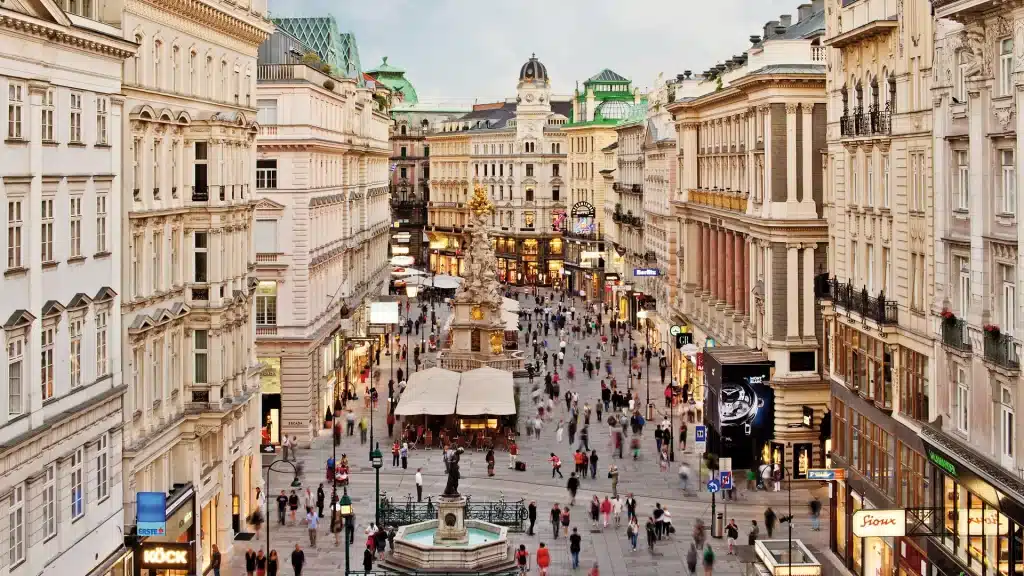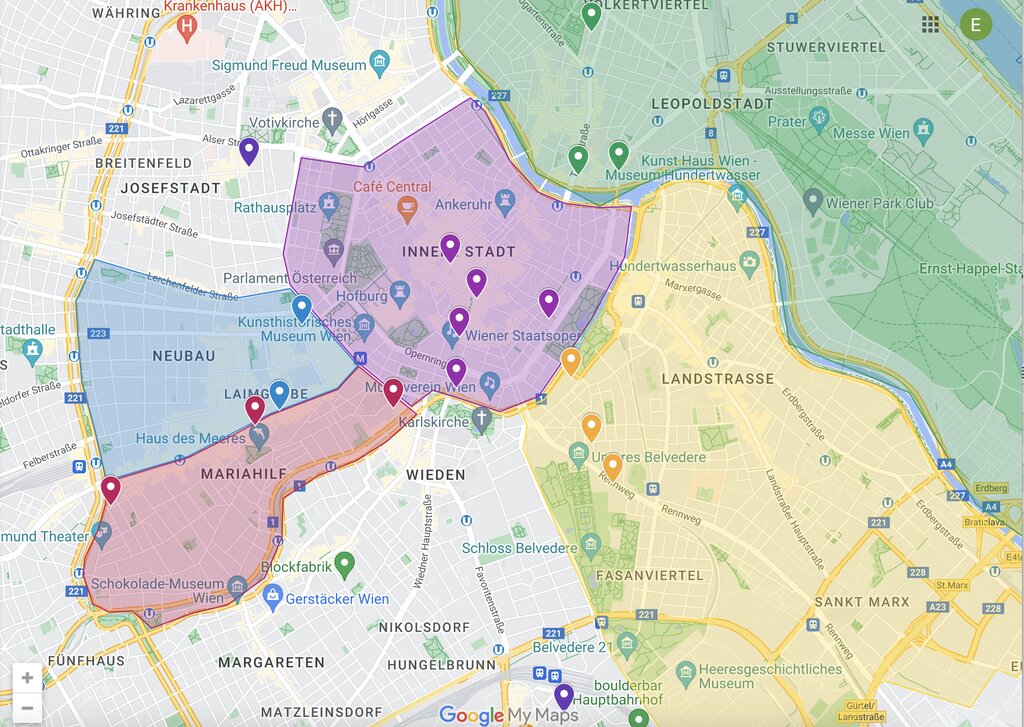Have you ever wondered why you should visit Vienna, the Austrian capital, and what is so special about it? If you’d like to learn more, please stay with us. Here in Our Vienna guide, we tend to answer many of your questions.

©©Wien Info
Our website includes affiliate links. So, remember that we may receive commissions when you click our links and make purchases. Please read our legal disclaimer document for more information about our Affiliate disclaimer and other disclaimers like the Fair-Use disclaimer.
Vienna, the capital of Austria, is a city that seamlessly blends its imperial past with a dynamic modern culture. As Austria’s largest city and one of Europe’s most enchanting capitals, Vienna is renowned for its exquisite architecture, rich history, world-class music, and culinary treats. The city’s stunning architecture, steeped in history, and its vibrant modern culture are sure to captivate any visitor. Located in the eastern part of the country along the banks of the Danube River, Vienna serves as Austria’s cultural and political hub and a gateway to the rest of Europe.
Preparing for your visit
Understanding Vienna’s rich history is a crucial step when planning a trip. This knowledge will enrich your visit and help you appreciate the city’s cultural heritage. Start by reading our practical information about traveling to Vienna and exploring the different areas and places to see. Then, delve into the museums that pique your interest the most.
Vienna Guide travel advice
When traveling to Vienna, Austria, it’s essential to know the travel documentation required based on your nationality and whether you need a visa. Citizens of the European Union and the European Economic Area do not need a visa to enter Austria. They will only need a valid passport or national identity card. American citizens traveling to Austria for less than 90 days do not need a visa, but they must have a valid passport for at least six months beyond their intended stay. Furthermore, immigration officers may ask visitors to provide evidence of adequate funds for their stay and a return airline ticket. This practical advice will ensure you’re well-prepared for your trip.
Language
The official language of Vienna is German. While English is widely understood, some restaurants may have German-only menus and German-speaking staff. Instead of becoming fluent in German for your trip, consider printing out our list of essential phrases and expressions to use during your travels.

©Wien Info
Weather
Vienna has a dry continental climate with warm summers and cold winters. The hottest months are June, July, and August, with average temperatures around 20°C. It rains throughout the year, with the most abundant rainfall in summer. December and January are the coldest months, with average temperatures around 0°C. Summer is the most popular time to visit Vienna, but spring and autumn are also mild, and winter offers holiday festivities. Well, you are the one who knows what the best time to visit Vienna is, right?
How to Stay Safe in Vienna
While Vienna is generally safe, it’s essential to be cautious of pickpocketing in crowded areas such as the 1st and 4th Districts. Avoid purchasing event tickets from street sellers, and be wary of individuals posing as police officers and asking to see your passport. Solo female travelers should take standard safety precautions. In case of emergencies, dial 112. Trust your instincts and consider purchasing travel insurance for comprehensive protection. These safety measures are in place to ensure your peace of mind during your visit to Vienna.
Getting to Vienna
When traveling to Vienna, you can fly, take a train, or use a bus, as the city is well-connected to the rest of the world. Vienna International Airport is about 16 km southeast of central Vienna. It offers various public transit options to the city center, including the City Airport Train (C.A.T.), ÖBB Railjet, Express Train S7, and bus connections.
The City Airport Train (C.A.T.) takes 16 minutes to reach downtown Vienna and departs every 30 minutes. The ÖBB Railjet travels to Vienna Main Station in 15 minutes and Wien Meidling Station in about 30 minutes. The rapid transit railway line S7 takes about 30 minutes to reach the city center. Several bus connections are also available to different parts of the city.
Note: If you want to find great flight deals, check Skyscanner. However, if you’d like to find and compare great bus and train prices, visit the Omio App.
Getting Around
Vienna’s public transportation system, operated by Wiener Linien, includes a subway, trams, and buses. The Vienna City Card offers free public transport for 24, 48, or 72 hours and provides over 210 discounts at various attractions. Biking, walking, taxis, and ride-sharing services like Uber are also available. The U-Bahn runs from 5:00 am to 12:30 am, with trains every 5 minutes during regular schedules. The tram system consists of 30 lines and operates from 5 am to midnight, with some lines changing schedules on weekends and holidays. Night buses run between 12:30 am and 5 am every 30 minutes. You can purchase it at ticket offices, machines, tobacconists, or a cell phone app. Children up to six travel free, and those under 15 travel free on Sundays, public holidays, and school vacations. Seniors over 65 can get discounted tickets. Wien Hauptbahnhof offers international and regional connections, and there’s an international bus terminal next to the train station. Twin City Liners operates a 75-minute boat service between Bratislava and Vienna during the summer.
Vienna City Card
The Vienna Card offers free unlimited use of public transport and discounts at the city’s leading museums, monuments, and attractions for 24, 48, or 72 hours. You can easily purchase it at the airport, train stations, tourist information offices, most hotels, or by cell phone, making your travel experience more convenient and enjoyable. With the Vienna City Card, you can easily navigate the city and make the most of your visit.
How many days do you need for a Vienna visit?
How many days do you need to visit Vienna? Vienna has dozens of attractions and landmarks worth visiting, so you will need at least five days to explore it fully. However, you can squeeze your visit into two to three days for quick and sweet visits.
The duration of your visit will also depend on the time of year since each season brings different events and attractions. For example, if you come in December, you might spend a few days just going around Christmas markets alone. On the other hand, summer brings more outdoor activities, such as parks, forests, and river cruises.

©Wanderlust with kids
Best areas to stay in Vienna
Vienna is one of the most expensive cities, so book your accommodation ahead. You can find great prices for city center rooms. Discover where to stay in the Austrian capital.
- Innere Stadt: The historic center is easily accessible to museums, the Cathedral, Hofburg, and public transportation. Accommodation is the most expensive here.
- Landstrasse: A central area with access to attractions like Belvedere Palaces and Hundertwasserhaus. It’s ideal for city center proximity without high prices.
- Neubau: A trendy area with art galleries and Third Wave coffee shops. It’s ideal for indie exploration and families interested in child-friendly museums at the Museumsquartier.
- Wieden: An energetic district with the University of Vienna campus, hipster cafes, bars, and boutiques. It offers a wide range of prices.
- Hietzing: A quiet neighborhood featuring former aristocratic residences and Schonbrunn Palace. It’s a great escape for families with lower average prices than the city center.
If you want to find suitable accommodation in those areas, we suggest visiting Expedia.com.
Vienna Opening Times
In Vienna, shops with varying hours are typically open from Monday to Saturday. Some shopping centers have extended hours until 8 p.m. or 9 p.m. on weekdays. On Sundays and holidays, shopping is available at major railway stations, airports, and museum shops. Most shops in Vienna do not operate 24 hours. The city’s museums have varying opening hours but are generally open between 10 a.m. and 5 p.m. Some large museums offer extended evening hours once a week, staying open until 8 p.m. or 9 p.m.
Vienna attractions you don’t want to miss
Vienna seamlessly blends Baroque splendor with modern vibrancy. It would help if you visited attractions such as Schönbrunn Palace, Museums Quartier, Vienna State Opera, St. Stephen’s Cathedral, and Prater. You cannot miss the renowned Vienna Opera and the Belvedere Palace, which houses an imperial gallery. For more information about Vienna’s major attractions, visit our related article.
Vienna Pass
The Vienna Pass provides free entry to over 70 attractions, including the Schönbrunn and Hofburg palaces, the tourist bus, the Cathedral, and Mozarthaus. It’s a great way to save money on your trip and offers skip-the-line access at many attractions. Purchase the pass online in advance to save time and avoid complications. You can also opt for the Vienna Flexi Pass, which provides access to 2, 3, 4, or 5 attractions in the Austrian capital.
Note: If you want to learn more about Vienna’s top attractions, we recommend reading our related article. However, if you are interested in the most appealing day trips, we recommend reading our article Most Pleasant One-Day Trips from Vienna.
FAQs
How many days should I spend in Vienna?
A 3-4 days in Vienna would be ideal to fully explore the city’s key attractions, including Schönbrunn Palace, the Spanish Riding School, and the enjoyable Prater amusement park.
What is the best time of year to visit Vienna?
The best time to visit Vienna is from April to October. DuriThether is usually dry and warm, but during this month, it is suitable for outdoor activities and sightseeing. The city also hosts numerous cultural festivals in summer.
How do I get around Vienna?
Vienna offers a range of public transportation options, including trams, buses, and an efficient metro system. Bicycles are also popular due to the city’s extensive bike paths. Taxis and ride-sharing services are also readily available.
What are the best neighborhoods to visit in Vienna?
The best neighborhoods to visit in Vienna include the historic Inner Stadt for its imperial architecture, trendy Leopoldstadt for the iconic Prater Park, and Neubau for its hip boutiques and coffee shops.
What are the best places to go shopping in Vienna?
Vienna offers several shopping areas, from high-end fashion boutiques on Kohlmarkt and Graben to independent designers and vintage stores in Neubau.
What are the best places to get food in Vienna?
The Naschmarkt is a must for food lovers — it has more than 120 food vendors and restaurants. If you want to try the best food in Vienna, order a Wiener Schnitzel and a Sachertorte.
How to visit Vienna on a budget?
Vienna is pricey, but with some planning, you can save money. Book flights and hotels early, use tourist passes for sightseeing, and consider travel cards for public transport to cut costs.
Is Vienna LGBT+ friendly?
Shortly, yes! Vienna, the capital of Austria, has an active LGBTQIA+ community. Therefore it is considered Austria’s queer capital, with several LGBTQIA+ spaces, organizations and a history of LGBTQIA+ activism going back to the late 19th century. However, if you want to discover more, we suggest reading our article, Gay Vienna.
Take a look at

Most pleasant One-Day Trips from Vienna
Why did we write the article Most Pleasant One-Day Trips from Vienna in the first place? Let’s suppose you want

What to eat and drink in Vienna
Vienna, the heart of Austria, is globally known for its sweet treats and coffee. Exploring Viennese cuisine is essential for

Our Budapest gay travel guide
This is Our Budapest gay travel guide. We will cover the city’s major attractions, best accommodations, bars, gay events, and
References and sources:
Photo credits:
Feature photo Credits: ©Wien Info

